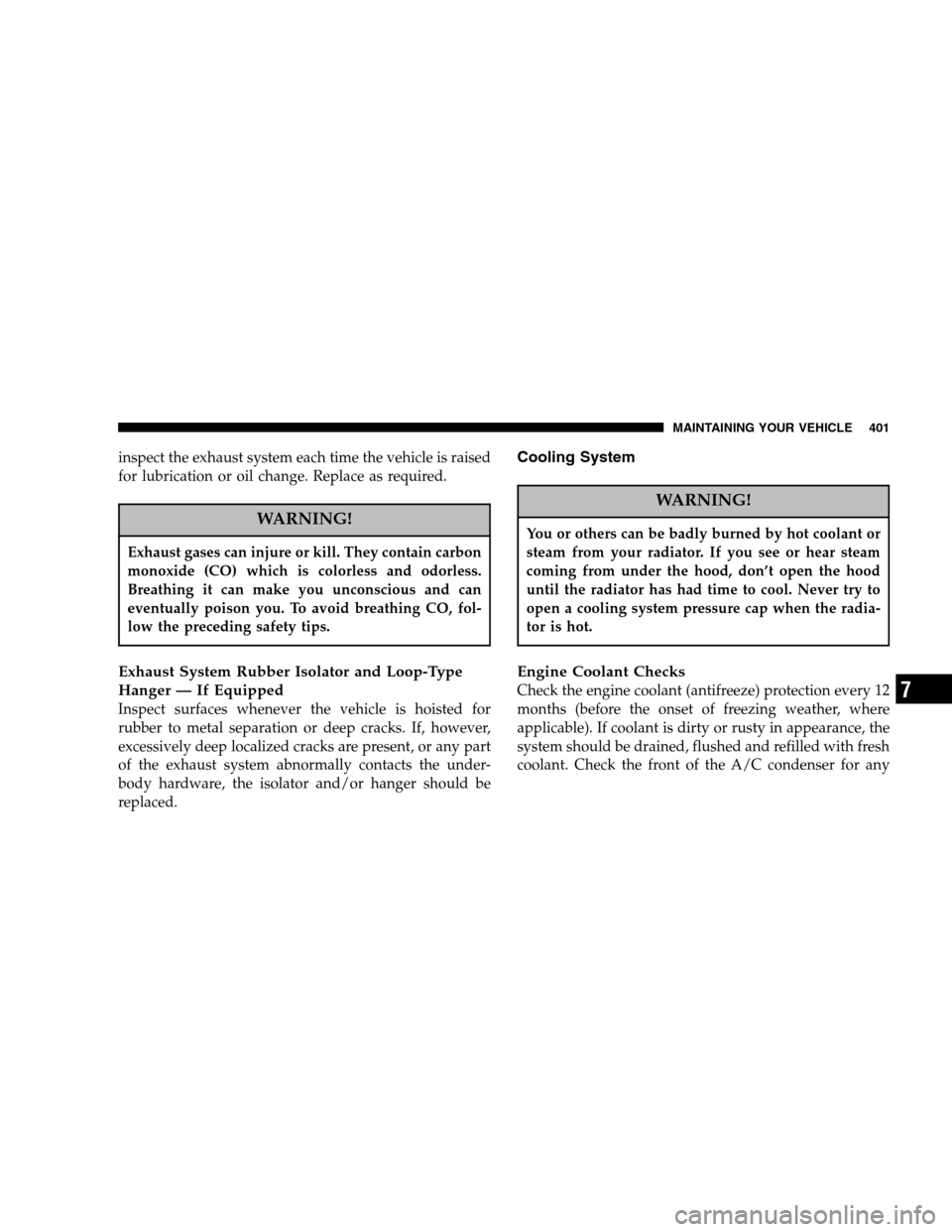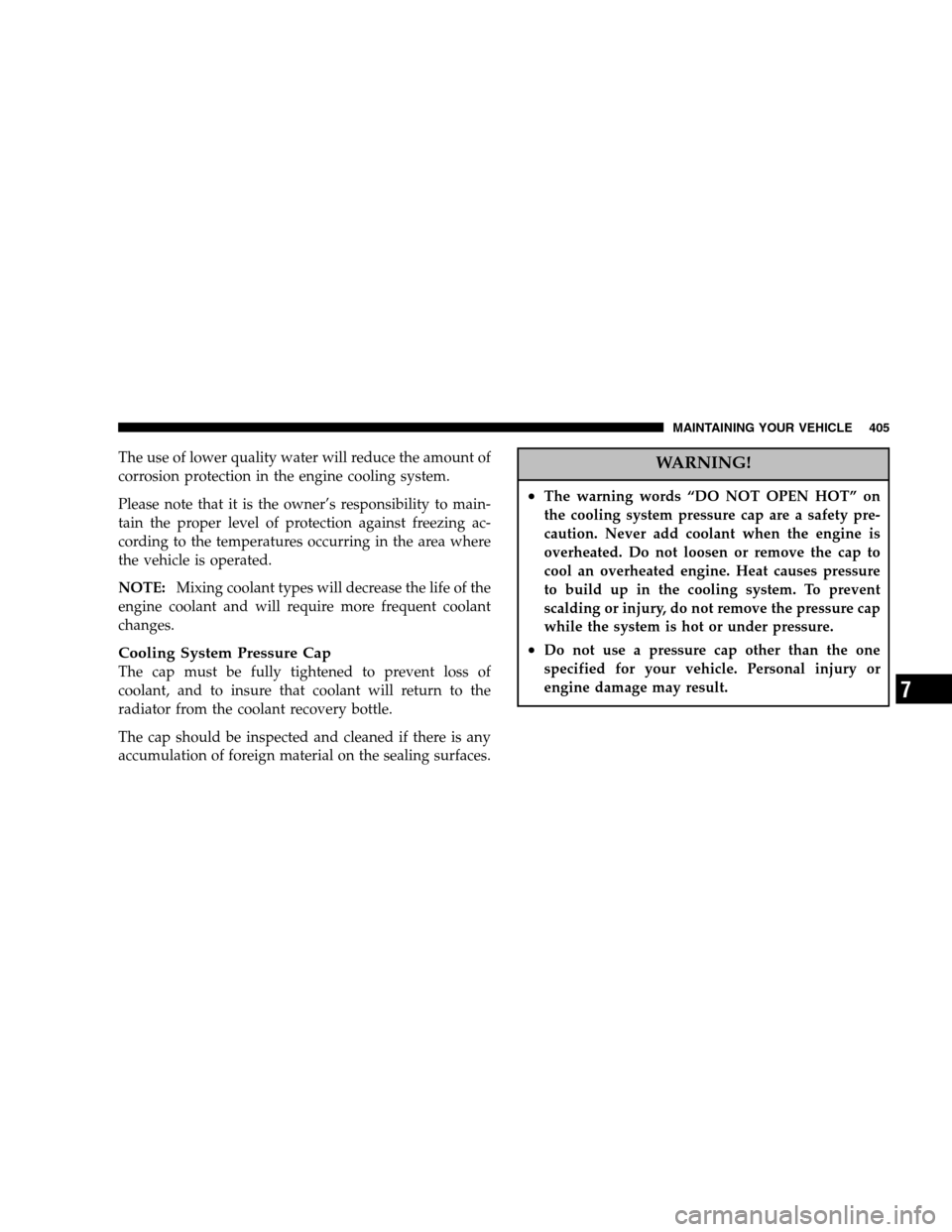2007 DODGE RAM 2500 DIESEL radiator cap
[x] Cancel search: radiator capPage 265 of 496

Driving
Condition Load Turbo-
charger
Temperature Idle Time
(min.)
Before
Engine
Shutdown
Stop and Go Empty Cool Less than
One
Stop and Go Medium One
Highway Speeds Medium Warm Two
City Traffic Maximum GCWR Three
Highway Speeds Maximum
GCWR Four
Uphill Grade Maximum
GCWR Hot Five
Engine Speed Control
CAUTION!
Prevent overspeeding the engine going down hill.
When descending steep grades, use a combination of
gears and service brakes to control vehicle/engine
speed. Overspeed can cause severe engine damage.
Operating Precautions
Avoid Overheating The Engine
The temperature of the coolant (a mixture of 50%
ethylene-glycol and 50% water) must not exceed the
normal range of the temperature gauge (240°F/116°C)
with a 16 psi (110 kPa) radiator cap.
Usually the coolant temperature indicated during opera-
tion will be to the left of center in the normal range of the
gauge.
STARTING AND OPERATING 265
5
Page 401 of 496

inspect the exhaust system each time the vehicle is raised
for lubrication or oil change. Replace as required.
WARNING!
Exhaust gases can injure or kill. They contain carbon
monoxide (CO) which is colorless and odorless.
Breathing it can make you unconscious and can
eventually poison you. To avoid breathing CO, fol-
low the preceding safety tips.
Exhaust System Rubber Isolator and Loop-Type
Hanger — If Equipped
Inspect surfaces whenever the vehicle is hoisted for
rubber to metal separation or deep cracks. If, however,
excessively deep localized cracks are present, or any part
of the exhaust system abnormally contacts the under-
body hardware, the isolator and/or hanger should be
replaced.
Cooling System
WARNING!
You or others can be badly burned by hot coolant or
steam from your radiator. If you see or hear steam
coming from under the hood, don’t open the hood
until the radiator has had time to cool. Never try to
open a cooling system pressure cap when the radia-
tor is hot.
Engine Coolant Checks
Check the engine coolant (antifreeze) protection every 12
months (before the onset of freezing weather, where
applicable). If coolant is dirty or rusty in appearance, the
system should be drained, flushed and refilled with fresh
coolant. Check the front of the A/C condenser for any
MAINTAINING YOUR VEHICLE 401
7
Page 402 of 496

accumulation of bugs, leaves, etc. If dirty, clean by gently
spraying water from a garden hose vertically down the
face of the condenser.
Check the coolant recovery bottle tubing for brittle rub-
ber, cracking, tears, cuts and tightness of the connection
at the bottle and radiator. Inspect the entire system for
leaks.
Extremely cold ambient temperature may require the
addition of a “winter front” for effective operation of the
cab heating/cooling system. Make certain that a percent-
age of the radiator is exposed for adequate air flow
through the charge air cooler and automatic transmission
oil cooler. The percentage of opening must be increased
with the increasing ambient air temperature and/or
engine load. If the cooling fan can be heard cycling
frequently, increase the size of the opening in the winter
front.Coolant bottle level check
The coolant reserve system provides a quick visual
method of determining that the coolant level is adequate.
With the engine idling, and warmed to the normal
operating temperature, the level of the coolant on the
coolant bottle should be between the fluid level marks.
Check the coolant level whenever the hood is raised.
The radiator normally remains completely full, so there is
no longer a need to remove the coolant pressure cap
except for checking coolant freeze point or replacement
with new antifreeze coolant.
402 MAINTAINING YOUR VEHICLE
Page 403 of 496

WARNING!
Never add coolant to the radiator when the engine is
overheated. Do not loosen or remove pressure cap to
cool overheated engine! The coolant is under pres-
sure and severe scalding could result.
Cooling System — Drain, Flush and Refill
At the intervals shown on the Maintenance Schedules,
the system should be drained, flushed and refilled.
If the solution is dirty or contains a considerable amount
of sediment, clean and flush with a reliable cooling
system cleaner. Follow with a thorough rinsing to remove
all deposits and chemicals. Properly dispose of old
antifreeze solution.
Selection Of Coolant
Use only the manufacturers recommended coolant, refer
to Fluids, Lubricants and Genuine Parts for correct
coolant type.
MAINTAINING YOUR VEHICLE 403
7
Page 405 of 496

The use of lower quality water will reduce the amount of
corrosion protection in the engine cooling system.
Please note that it is the owner’s responsibility to main-
tain the proper level of protection against freezing ac-
cording to the temperatures occurring in the area where
the vehicle is operated.
NOTE: Mixing coolant types will decrease the life of the
engine coolant and will require more frequent coolant
changes.
Cooling System Pressure Cap
The cap must be fully tightened to prevent loss of
coolant, and to insure that coolant will return to the
radiator from the coolant recovery bottle.
The cap should be inspected and cleaned if there is any
accumulation of foreign material on the sealing surfaces.
WARNING!
•The warning words “DO NOT OPEN HOT” on
the cooling system pressure cap are a safety pre-
caution. Never add coolant when the engine is
overheated. Do not loosen or remove the cap to
cool an overheated engine. Heat causes pressure
to build up in the cooling system. To prevent
scalding or injury, do not remove the pressure cap
while the system is hot or under pressure.
•Do not use a pressure cap other than the one
specified for your vehicle. Personal injury or
engine damage may result.
MAINTAINING YOUR VEHICLE 405
7
Page 406 of 496

Disposal Of Used Engine Coolant
Used ethylene glycol based engine coolant is a regulated
substance requiring proper disposal. Check with your
local authorities to determine the disposal rules for your
community. Do not store ethylene glycol-based engine
coolant in open containers or allow it to remain in
puddles on the ground. Prevent ingestion by animals and
children. If ingested by a child, contact a physician
immediately. Clean up any ground spills immediately.
Coolant Level
The coolant bottle provides a quick visual method for
determining that the coolant level is adequate. With the
engine cold, the level of the coolant in the coolant
recovery bottle should be between the ranges indicated
on the bottle.
The radiator normally remains completely full, so there is
no need to remove the radiator cap unless checking for
coolant freeze point or replacing coolant. Advise your service attendant of this. As long as the engine operating
temperature is satisfactory, the coolant bottle need only
be checked once a month.
When additional coolant is needed to maintain the
proper level, it should be added to the coolant bottle. Do
not overfill.
Points To Remember
NOTE:
When the vehicle is stopped after a few miles (a
few kilometers) of operation, you may observe vapor
coming from the front of the engine compartment. This is
normally a result of moisture from rain, snow, or high
humidity accumulating on the radiator and being vapor-
ized when the thermostat opens, allowing hot coolant to
enter the radiator.
If an examination of your engine compartment shows no
evidence of radiator or hose leaks, the vehicle may be
safely driven. The vapor will soon dissipate.
406 MAINTAINING YOUR VEHICLE
Page 479 of 496

Axle Fluid.......................... 412,447
Axle Lubrication (Axle Fluid) ............... 412
Ball Joints ............................. 397
Battery ............................... 394
Blanket .......................... 262,396
Emergency Starting ..................... 367
Keyless Transmitter Replacement (RKE) ....... 23
Saving Feature (Protection) ............... 124
Bearings .............................. 415
Belts, Drive ............................ 389
Belts, Seat .............................. 32
Body Mechanism Lubrication ............... 399
B-Pillar Location ........................ 300
Brake Fluid ............................ 447
Brake System ........................ 291,409
Anti-Lock (ABS) ....................... 292
Disc Brakes .......................... 409
Fluid Check .......................... 409 Hoses
.............................. 411
Master Cylinder ....................... 409
Parking ............................. 290
Warning Light ........................ 184
Bulb Replacement ....................... 433
Bulbs, Light ............................ 432
Cab Top Clearance Lights .................. 441
Calibration, Compass ..................... 141
Camper ............................... 170
Capacities, Antifreeze (Engine Coolant) ........ 445
Capacities, Fluid ........................ 445
Caps, Filler Power Steering ........................ 397
Radiator (Coolant Pressure) ............... 405
Car Washes ............................ 422
Carbon Monoxide Warning ...............73,172
Cargo Light ............................ 126
Cassette Tape and Player Maintenance ......... 232
INDEX 479
10
Page 480 of 496

CD (Compact Disc) Player............190,198,211
Cellular Phone .......................... 87
Center High Mounted Stop Light ............ 440
Center Lap Belts ......................... 42
Center Seat Storage Compartment .........159,160
Certification Label ....................... 323
Charge Air Cooler ....................... 408
Chart, Tire Sizing ........................ 297
Check Engine Light (Malfunction Indicator Light) . 183
Child Restraint ........................ 57,58
Child Restraint Tether Anchors .............62,66
Child Seat ............................ 58,65
Cigar Lighter ........................... 154
Cleaning Wheels ............................. 424
Climate Control ......................... 234
Clock ..................... 187,192,200,213,226
Clutch Linkage Maintenance ................ 411
Compact Disc (CD) Maintenance ............. 233 Compact Spare Tire
...................... 308
Compass ........................... 140,141
Compass Calibration ..................... 141
Compass Variance ....................... 142
Computer, Trip/Travel .................... 137
Console, Overhead ....................... 136
Contract, Service ........................ 472
Coolant Pressure Cap (Radiator Cap) .......... 405
Cooling System ......................... 401
Adding Coolant (Antifreeze) .............. 404
Coolant Capacity ...................... 445
Coolant Level ................... 401,402,406
Disposal of Used Coolant ................ 406
Drain, Flush, and Refill .................. 403
Inspection ........................... 406
Points to Remember .................... 406
Pressure Cap ......................... 405
Radiator Cap ......................... 405
Selection of Coolant (Antifreeze) .........403,446
480 INDEX